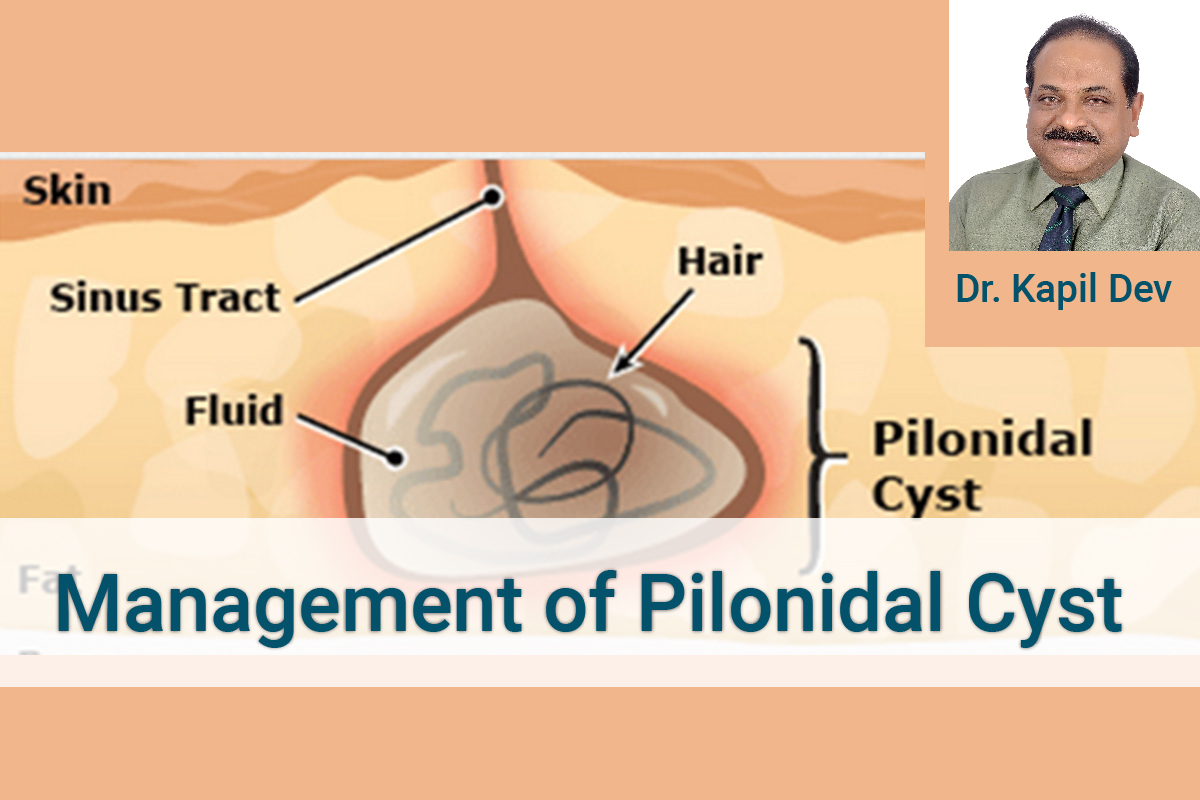- Home
- Editorial
- News
- Practice Guidelines
- Anesthesiology Guidelines
- Cancer Guidelines
- Cardiac Sciences Guidelines
- Critical Care Guidelines
- Dentistry Guidelines
- Dermatology Guidelines
- Diabetes and Endo Guidelines
- Diagnostics Guidelines
- ENT Guidelines
- Featured Practice Guidelines
- Gastroenterology Guidelines
- Geriatrics Guidelines
- Medicine Guidelines
- Nephrology Guidelines
- Neurosciences Guidelines
- Obs and Gynae Guidelines
- Ophthalmology Guidelines
- Orthopaedics Guidelines
- Paediatrics Guidelines
- Psychiatry Guidelines
- Pulmonology Guidelines
- Radiology Guidelines
- Surgery Guidelines
- Urology Guidelines
PILONIDAL SINUS, an agonising and discomforting disease- Dr Kapil Dev

There are many diseases which are life-threatening and need your immediate attention. But non-life threatening diseases due to their continuous pain, discomfort & mental agony catch up your attention much more. Pilonidal Sinus is one such disease. In Latin Pilo means hair & Nidal means nest.
The disease was discovered in 1867, was thought to be congenital at that time because of its location in the midline. It took 57 years for medical science to understand that it was acquired.
Points in favor of it being acquired are:
- It is uncommonly found in the axilla and interdigital space (barbers).
- Hair in the track is dead and there are no hair follicles in the wall.
- Recurrence is present.
Since then medical science has toiled to find a cure.
Thanks to the hard work of countless surgeons around the globe, sharing their experiences and learning together from their mistakes that it is now possible to cure Pilonidal Sinus completely.
Clinical features:
- It is characterized by an infected sinus containing dead hair with single or multiple openings. The single opening is always found in midline usually at last piece of the coccyx. Multiple openings up to 6 can also be seen.
- A small tuft of hair projects.
- Bloodstained foul-smelling discharge is present.
- No constitutional symptoms are there even at the peak of local symptoms.
- An abscess formed bursts into a primary midline opening or a secondary opening away from the midline.
Pathogenesis:
- Broken hair from as high as the nape of the neck and upper back collect at post anal dimple and nearby area. Broken infected perianal hair is also present in this area. Shearing action due to sitting on hard surface, the vibration of vehicle and moisture lead to the penetration of hair in an active sweat gland and broken skin. If dermatitis is present it facilitates hair entry and sinus is formed.
- Once a sinus is formed it sucks hair due to intermittent negative pressure. Inflammation, infection and purulent discharge follow.
Epidemiology:
- Age & sex: Mostly men 20 to 30 years of age, hairy. Male to female ratio is 4:1. Beyond 30 years of age in extremely hairy and obese. Obesity & deep buttocks add to the chances of Pilonidal Sinus.
- Professionally: People sitting for long hours like call center executives, drivers, are most susceptible to this disease.
Long sitting hours, hard sitting surfaces, vehicular vibration of seats & tight clothes create negative pressure which facilitates the sinus to suck broken hairs and create a nest of hairs.
So common was Pilonidal Sinus among JEEP DRIVERS in World War II that it came to be called as JEEP BOTTOM.
- By habit: People who use toilet paper are more prone as infected hair get entangled in tissue paper which sticks the perianal area.
- By race: Never in blonds as hair are soft.
Treatment:
- Conservative: In early stages, conservative treatment like cleaning the track, removing hair and antiseptic wash is enough to cure the disease. Treatment for an acute abscess is simple IND with small incision & broad-spectrum antibiotics cure the disease. But due to the absence of constitutional symptoms, the patient comes late and surgery is the only choice for a cure.
- Surgical: This is achieved by excision of sinus without primary closure option 1 or with primary closure option 2. In the first option, healing is by secondary intention. It's usually successful but healing time is 4-6 weeks with heavy dose of antibiotics & NSAIDs. Due to long recovery time patients lose on job & day to day normalcy. In the second option, there are various procedures described for primary closure like Bascom’s, Karyadaki’s, advancement flaps, etc. But the failure rate is as high as 50%.
- Advanced treatment: Micro Endoscopic Cryo Surgery has answered the limitation of conventional treatment. First, we have to determine the extent of the disease. We inject dye into the sinus & visualize the complete track of the sinus. With the help of microendoscope from the primary opening we clean the track till the last. As there is no incision recovery is fast, no heavy dose of antibiotics, and NSAIDs is required. The patient can attend to his professional duties and personal life from the same day. The miracle combination of skill & technique has been bringing a big smile to the millions of ailing patients who have suffered recurrence and failures.
Prevention: People with excess sweat and obesity must wear loose clothes, keep the area dry, remove of hair regularly and undergo weight loss.
Recurrence: Most common cause is primary closure and the lack of preventive measures as described above.
Dr. Kapil Dev (the author) is a Consultant Bariatric Surgeon and Laparoscopic Surgeon at Apollo hospitals in New Delhi. He has held esteemed posts and renowned awards and is amongst one of the top surgeons of the country.

Disclaimer: This site is primarily intended for healthcare professionals. Any content/information on this website does not replace the advice of medical and/or health professionals and should not be construed as medical/diagnostic advice/endorsement or prescription. Use of this site is subject to our terms of use, privacy policy, advertisement policy. © 2020 Minerva Medical Treatment Pvt Ltd